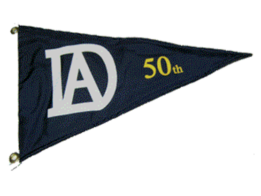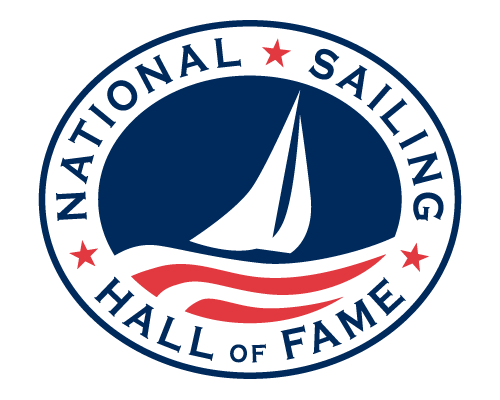Dickerson Owners Association

 Stories from the Dickerson Owners Association
Stories from the Dickerson Owners Association
Dickerson Owners Association
Website: www.dickersonowners.org
History
The Early Years
Dickerson Boatbuilders was a company with a storybook history. Bill Dickerson started his company in his own back yard on Church Creek near Cambridge, Maryland in 1946. For twenty years he built a variety of pleasure boats that ranged from compact day sailers to a 5 8' schooner.
Although Bill Dickerson built a number of different types of boats, they all shared common characteristics. His boats were rugged and capable of taking whatever conditions the sea delivered. And they all evolved in response to specific needs of the marketplace.
"Simplissima"
 One boat in particular typified Bill Dickerson's approach to boatbuilding and became a legend of sorts on the Chesapeake Bay during the 1950's. This 34 foot hard-chined ketch, a descendent of the Chesapeake Bay skipjack, was the perfect family gunkholer. With a 2 foot draft (with board up) she could get in and out of the many shallow coves and harbors of the bay. And, a relatively narrow beam of 9'6" made her a seakindly boat that performed well. Accommodations were spartan, yet the bugeye cabin was airy and quite comfortable for a small family. This boat became known as the "Simplissima" and more than 50 of them were built.
One boat in particular typified Bill Dickerson's approach to boatbuilding and became a legend of sorts on the Chesapeake Bay during the 1950's. This 34 foot hard-chined ketch, a descendent of the Chesapeake Bay skipjack, was the perfect family gunkholer. With a 2 foot draft (with board up) she could get in and out of the many shallow coves and harbors of the bay. And, a relatively narrow beam of 9'6" made her a seakindly boat that performed well. Accommodations were spartan, yet the bugeye cabin was airy and quite comfortable for a small family. This boat became known as the "Simplissima" and more than 50 of them were built.
Following the success of the "Simplissima" Dickerson made a number of 26' hard-chined sloops and 32' hard-chined known as the "Simplissima" class, aft-cockpit ketches. Both of these boats became popular family cruisers because of their sturdy construction and reasonable cost.
In the early sixties, Bill Dickerson's reputation for building rugged boats awarded him a contract to build a series of U.S. Navy patrol boats. During this time a number of pleasure trawlers were also built. Dickerson was establishing his identity as a quality builder responding to a variety of needs.
As both owners and prospective buyers asked for a larger, more refined boat, Dickerson responded with the introduction of the 35' hard-chined, aft-cockpit ketch. This boat was to become the basis for a number of evolutionary designs throughout the sixties and seventies. Later the Dickerson 35 center-cockpit, round bilge was introduced as an alternative to the aft-cockpit model giving the cruising family the privacy of two sleeping cabins. The Dickerson 35 (later to become the 36 with her modified clipper bow) is still very much a part of today's sailing scene with active associations on the Long Island Sound and Chesapeake Bay.
Bill Dickerson retired and sold his company in 1967 to Thomas Lucke who then moved the company to its present location on La Trappe Creek in Trappe, Maryland. During the late sixties he continued to build the popular 35' strip plank mahogany ketches and the Dickerson 40 ketch, first introduced by Bill Dickerson.
By today's standards these boats were not fancy, especially down below. But Dickerson's reputation for well-built boats of real value grew stronger. More and more Dickersons were being seen along the mid-Atlantic coast, and several were being sailed south in the winter. Dickerson was becoming an important, yet still small, part of the east coast boatbuilding industry.
The Lucke Years
Tom Lucke decided that fiberglass had finally proven itself as a strong, reliable boatbuilding material. Fiberglass hulls replaced wood hulls. And eventually wood decks and cabins were made of fiberglass covered marine plywood.
 In 1974 the wooden Dickerson 40 was discontinued and a new 4I' ketch with a fiberglass hull was introduced. Tom recognized the growing needs of the cruising family, and as the years progressed so did the detail of the interior work. While value and rugged construction remained the strong points of Dickerson, the 36' and 4l provided the comfort and luxury that people were asking for.
In 1974 the wooden Dickerson 40 was discontinued and a new 4I' ketch with a fiberglass hull was introduced. Tom recognized the growing needs of the cruising family, and as the years progressed so did the detail of the interior work. While value and rugged construction remained the strong points of Dickerson, the 36' and 4l provided the comfort and luxury that people were asking for.
The circumnavigation that started a new era
In 1975 a Dickerson 41 owned by Neville Lewis began a four year circumnavigation. Joining the Lewis family from Puerto Rico to Tahiti was Ted Reed, a blue water sailor and businessman. Ted was so impressed with Neville's Dickerson 41, that he decided to have one built for himself This decision was the beginning of Dickerson's new era of the eighties. In 1978 Ted, his wife and a close business associate bought the company, and the next era of Dickerson had begun.
Dickerson of the 80's
 Much has happened since 1978. Ted wanted to maintain much of the tradition of Dickerson, but he also wanted to modernize the designs and boatbuilding techniques. He began by commissioning George Hazen, a naval architect intimately familiar with Dickerson, to design an new high performance cruiser. As a young man, George spent his summers cruising the Chesapeake Bay on his father's hard-chined Dickerson 35 and later on a newer, round-bottom, full keel Dickerson 35.
Much has happened since 1978. Ted wanted to maintain much of the tradition of Dickerson, but he also wanted to modernize the designs and boatbuilding techniques. He began by commissioning George Hazen, a naval architect intimately familiar with Dickerson, to design an new high performance cruiser. As a young man, George spent his summers cruising the Chesapeake Bay on his father's hard-chined Dickerson 35 and later on a newer, round-bottom, full keel Dickerson 35.
Studying naval architecture and marine engineering at Princeton, George won national acclaim for his honors thesis, "The Use of a Computer to Analyze Flow Patterns Around a Hull." After receiving his Master's degree in Naval Architecture from M.I.T. and serving as a full-term member of the H. Irving Pratt project which developed the MHS rule, George spent several years designing racing and cruising boats. He later opened his own naval architect's office in Annapolis and developed a computer-aided design program which virtually replaced tank testing.
The evolution of the modern Dickerson had begun, and in 1981, after three years of development, the first Dickerson 37 was launched. The familiar Dickerson full keel design was replaced by a moderate fin keel and skeg hung rudder that reduced wetted surface area and improved maneuverability while at the same time maintaining good tracking ability. End grain balsa cored fiberglass was used for the hull and deck because of its light weight and proven strength. Above the waterline, the traditional look of Dickerson remained.
In 1982 the first Dickerson 50 was presented at the Newport International Sailboat Show, and in 1983 the first Farr-designed 37' racing sloop was launched and began winning every race it entered.
